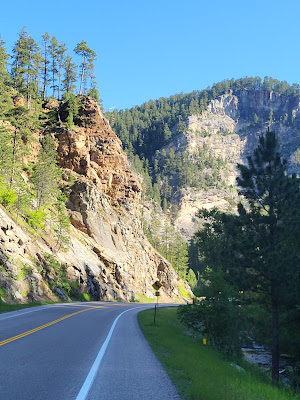On August 19, I rode the recently-approved Frisco - Ute Pass 101 km Permanent Populaire. This is a route designed by Mark Rada (RUSA #13243). A friend had recommended Ute Pass years ago, but I never had a good ride concept that included Ute Pass (and justified the two-hour drive to get there). So with this new perm in place, off I went!
Wednesday, August 20, 2025
Riding the Frisco - Ute Pass 101k Permanent Populaire
The elevation profile is interesting. Only about a third of the climbing is up Ute Pass (5.1 miles), the big hump in the middle of the chart below. And the Swan Mountain Road, towards the end of the route, is only a few dozen feet lower than Ute Pass. And what are the saw teeth in between Ute Pass and Swan Mountain? Just a neighborhood on the edge of Silverthorne. So this is a route that can deceive climbing expectations unless you pay attention.
It was 55° starting off at the Tenmile Creek Trailhead just before 7:00, and 80° finishing. So a great day to be up in the mountains, rather than down on the Plains, where it got into the low 90's.
Trail map at start of route
After coasting a mile down Main St., it was onto the Dillon Reservoir Recpath, a winding wooded and scenic path. But as a recreational trail, it is twisting, with bumps and varied route surfaces, all of which keeps you on your toes.
On the dam, separated from traffic (motor road on the left).
From here, we turn onto the Silverthorne / Blue River path, which starts out by descending in half a dozen switchbacks down the side of the dam to Silverthorne and the Blue River Valley.
I had done so well staying on the route. But at the Wendy's on Rainbow Drive (noted on cue sheet), my luck ran out, and I couldn't find where the path continued. After a false start, I did find the route again, and then when the path vagaries became too unintelligible, hopped onto Blue River Parkway (Hwy. 9, the main drag), where the traffic wasn't actually too bad.
Downhill with a stiff tailwind, I sailed out into the countryside. I was just hoping the wind would turn up-valley by the time I was back down from the pass.
Blue River from Hwy. 9
The Ute Pass road is almost devoid of traffic, sage and grass at the base, getting more wooded higher up.
County Road 3 heralds the border between Summit County and Grand County.
Ute Pass Trailhead and info
Great views from the pass to the Blue River Valley.
And yes, descending to the base of the pass, the wind has turned predictably up-valley!
Next came the Tour-de-Neighborhoods, stiff climbs but quiet roads.
High point of the neighborhoods, and a checkpoint.
Good views to Silverthorne and south to Dillon.
And now it's time to retrace the Silverthorne Path switchbacks up the Dillon Reservoir Dam.
East side of Dillon Reservoir, on the way to Swan Mountain. There was some traffic on the path, but still fairly tranquil.
False summit of the Swan Mountain Path ...
... but nice views!
Actual high point (Sapphire Point), where you join the road. Bad road surface but very little traffic because of road reconstruction.
And a pleasant finish towards the Tenmile Creek Trailhead, where the Vail Pass Volley 200k also starts and finishes!
Thursday, August 14, 2025
Riding the Poudre Canyon - Rustic 300k Perm
This is our standard Poudre Canyon 300k brevet route, but ridden as a Permanent. Horsetooth Reservoir and Poudre Canyon are delightful quiet on a weekday.
Venus and Jupiter before dawn
Sunday, July 20, 2025
Spearfish Surprise 100k Permanent Populaire
On July 1, I rode the Spearfish Surprise 100k Permanent Populaire, during our visit to Spearfish Canyon, in the Black Hills of South Dakota.
The route divides into three distinct parts: forested Spearfish Canyon, with cliffs and rockfaces; the wide open prairie heading into Wyoming; and the connector through the town of Spearfish. In some ways this is more varied and interesting than a 100k totally in the Black Hills.
We were actually staying at the north end of the route, at the pleasant Spearfish Canyon Inn.
Early morning sun catching the cliff faces
The Spearfish Recreation Path was easy to find, pleasant and shady.

On Hillsview Road (the steepest grades of the entire route),
a new abbreviation ("S/D" for "subdivision").
The turnaround is through the NE Wyoming Visitors Center,
guarded by the only cattle guards on the route.
... with drinks, brochures, and restrooms.
Open landscape with reddish terrain
Nearby is the Vore Buffalo Jump,
an archeology site only discovered in the 1970's
... boasting multiple establishments.
to the lodge.
Subscribe to:
Comments (Atom)




















































